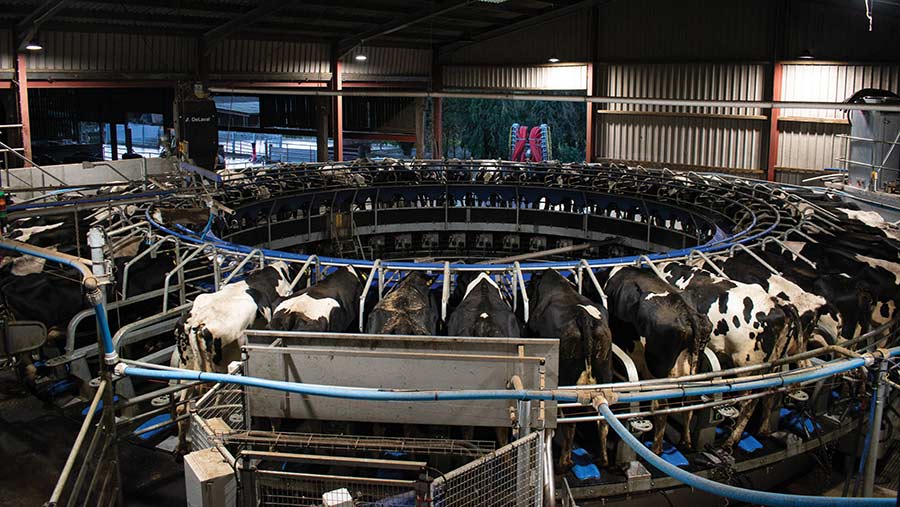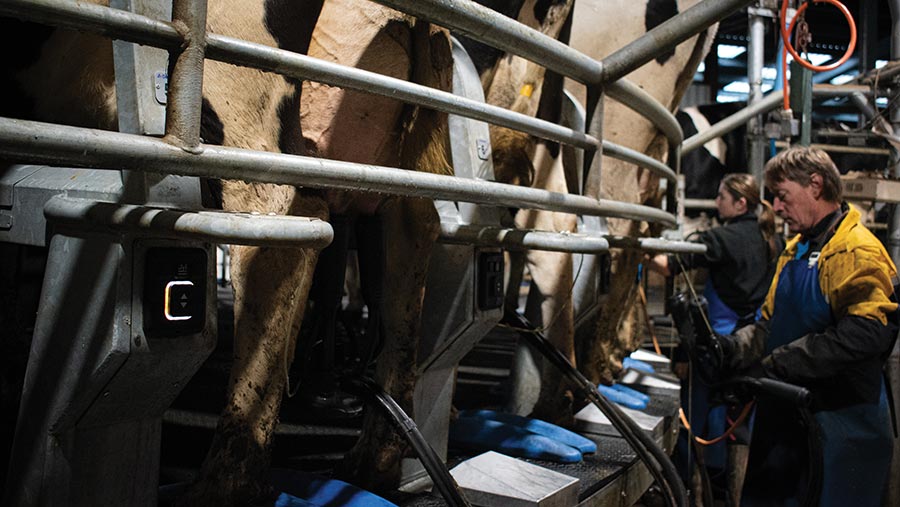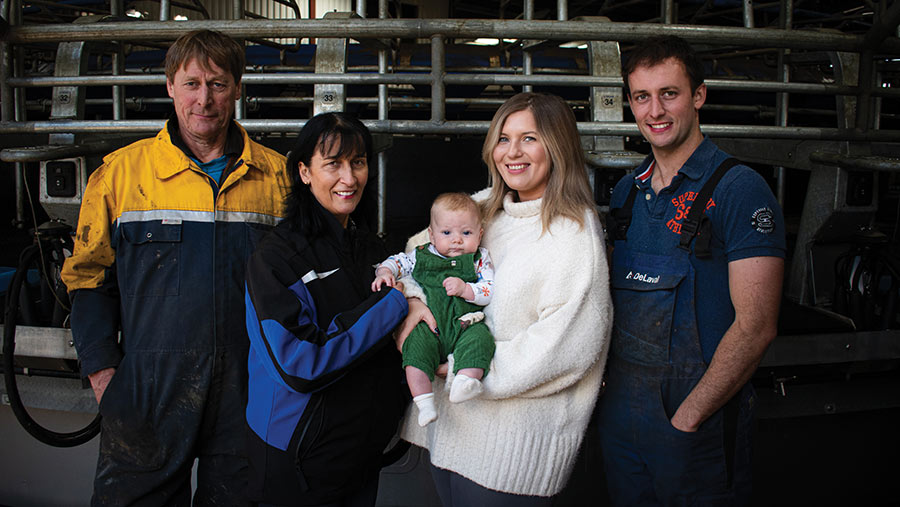Video: How a new parlour improved herd efficiency and health
 © Charlotte Cunningham
© Charlotte Cunningham Investment in a rotary parlour has helped a Devon dairy maximise efficiencies during milking of its 350-head Holstein Friesian herd, with milking time slashed by more than 50%, labour burdens eased and marked improvements in herd health.
The Retter family have been dairy farming at Home Farm, near Cullompton, for more than 70 years.
The decision to redesign the parlour was driven by fourth-generation farmer Will, who returned to the farm to work in 2020.
See also: What to consider when installing a rotary parlour
Farm facts: Home Farm, Bradfield, Devon

© Charlotte Cunningham
- 227ha
- 350 Holstein Friesians, plus followers
- Supplies Arla
- Yield: 9,900 litres, averaging 4.39% fat and 3.58% protein
- Year-round calving, with artificial insemination to sexed semen, and rearing all replacements
- Remaining calves reared for beef
- High-yielders housed, fed on a total mixed ration, with low-yielders and dry cows at grass in summer
“Previously, I had been working as an agricultural accountant off-farm. When I decided to come home, we were looking at budgets and the future of the farm and ultimately found ourselves faced with the decision of investing or giving up farming,” he explains.
Will farms in partnership with his father, Mervyn, and mother, Fiona, supported by his wife, Hannah. He says the decision was very much a family one.
“The old parlour was more than 30 years old, and it was taking us over five hours to milk 300 cows – it was a 12/24 herringbone with the jars in the centre and needed two or three of us [family members] in the parlour at any one time.
“This put a lot of pressure on everyone and as a family, there was no work-life balance. Having such long, labour-intensive milkings made staffing a challenge too.
“That said, we knew we didn’t want to give up the dairy and it had always been the goal to have a new parlour, so the decision was made to invest.”
Selecting a system
In early 2021, the family began looking at different types of parlours and systems to find one which would suit their 227ha (560-acre) farm.
“We looked at everything, including robots, but decided that wasn’t an option for us given the cost of maintenance and size of herd,” explains Will.
“We liked the idea of standing still while milking and we also wanted to significantly reduce milking times, so a rotary seemed a natural fit.”
They spent four months travelling the UK, looking at several different rotary parlours and milking systems to help decide on the specification they wanted.
“Every time we visited a new parlour, we saw something else that we thought might work well for us – there was so much to consider, from manufacturer, to size, to the in-parlour technology.”
The DeLaval system stood out for its simplicity, says Will, and with a good pre-existing relationship with local dealer BH White & Son, the family decided on a 50-point rotary from the manufacturer.
“This size parlour enables us to grow the herd slightly in the future if we want to, without significantly increasing milking time.
“We didn’t have to do any additional construction work, as it fitted perfectly in an existing shed that had previously been used for machinery and straw storage.”
Drawing on his accounting experience, Will forecast two seven-year budgets to finance the new parlour.
These were based on two milk prices: a “hopeful” base price of 28p/litre, and a “worst-case scenario” price of 26p/litre, both of which would enable the farm to afford the investment and remain profitable.
DeLaval helped with the financing of the parlour itself, while the construction cost was kept to a minimum by the Retters doing most of the build themselves.
Watch the video below to hear from Will about the family’s search for the right parlour and milking system.
Extra tech
To enhance the capabilities of the parlour, the family invested in additional technology to simplify the milking routine, improve cow health and milk hygiene, and cut labour requirement.
This included automatic cluster removers, milk meters, a feed-to-yield in-parlour feeding system, a FutureCow teat scrubber and a teat-spray robot for post-milking application.
The design also incorporated a segregation gate and pen.
The gate can be controlled via mobile application with the DeLaval software for easy and efficient animal handling for everything from vet visits to serving, says Will.
“This has been a really beneficial addition and enables us to be organised ahead of time. For example, on a Friday, we can pre-select which animals we want to be drafted for the herd health check the following week.
“Pulling individual animals was particularly challenging with the old system.”
Heat detection and rumination collars were introduced six months ago to complement the system, and have already benefited fertility, lowering calving interval from 410 to 370 days.
New housing
As well as the rotary parlour, new cow accommodation was built for the all-year-round calving herd.
“Previously, cows were housed in old loose yard accommodation,” says Will. “Mastitis was a real problem and we’d been wanting to upgrade to cubicles for a long time, so the new parlour marked a good time to do so.”
The new housing comprises 490 cubicles, with cows bedded on sand. This has improved cow comfort and health, and management in the parlour, as cows now come in for milking much cleaner.
As a result, teat preparation is a much simpler, streamlined process, he says.

Mervyn, Fiona, Tommy, Hannah and Will Retter © Charlotte Cunningham
Investment advantages
The build process started in February 2022, and the first milking in the new parlour took place eight months later, on 5 October.
Overall efficiency has been the biggest advantage, says Will.
“We’re now milking 310 cows, which takes two people about two hours, including washdown – it has made a massive difference.
“While we don’t necessarily need fewer staff now, everyone is working less, which keeps them all happier. Staffing is a hot topic, particularly in the dairy industry – no one wants to spend hours milking in an old, slow parlour.”
The combination of the new parlour and the accommodation has also led to a 70% reduction in mastitis cases and a significant improvement in milk hygiene.
“Our cell count has gone down from an average of 225,000 cells/ml in the old parlour to 125,000 in the new one.”
Bactoscan is also down, from 37,000 to 25,000/ml. Yield has benefited from the investment too, increasing from a lactation average of 8,300 litres in the old parlour to 9,900 litres in the rotary.
Will puts this down to three main factors:
- Milking is more efficient in the rotary, with every cow milked thoroughly
- Feeding to yield is a big improvement on the basic “high” and “low” settings in the previous parlour
- The significant reduction in mastitis means cows are healthier and producing more milk.
With a son, Tommy, born earlier this year, Will says the new system helps provide a better work-life balance and ensures the farm is in better shape for the long term, should the fifth generation want to take it on one day.
